Retrospective magnetic resonance imaging evaluation of fatty filum terminale in Kuwaiti population
- PMID: 25810641
- PMCID: PMC4367075
- DOI: 10.4103/0976-9668.149097
Retrospective magnetic resonance imaging evaluation of fatty filum terminale in Kuwaiti population
Abstract
Objective: Thickened fatty filum terminale (FFT) can cause tethered cord syndrome (TCS) and can be easily diagnosed on magnetic resonance (MR) imaging. We aimed to assess a) the incidence, distribution and clinical significance of the incidentally detected FFT in Kuwaiti population and b) the relationship between degenerative disk disease (DDD) and thickness of the FFT.
Materials and methods: A retrospective study was planned at Jaber Al Ahmad Armed Forces Hospital, Kuwait involving 1111 patients. A 1.5T GE machine was used for MR imaging to acquire multiplanar MR sequences. MR images of lumbar spine in 1111 subjects were reviewed and location, size, tightness of FFT, the DDD and clinical details were evaluated.
Results: FFT was observed in 43 out of 1111 (3.9%) subjects based on MRI, out of which 11 were females and 32 were males. The mean distance between the tip of conus medullaris and the FFT was 41 mm. The mean diameter of the FFT was 1.74 mm. 40 of 43 patients had DDD of varying severity on MR images and no significant or appreciable slackness of FFT was observed in these cases. There were no clinical symptoms related to FFT associated with degenerated disks.
Conclusion: FFT is frequently observed in Kuwaiti male population. No significant slackness of FFT was observed in cases with varying severity of DDD. There were no clinical symptoms related to FFT with or without degenerated disks.
Keywords: Degenerative disk disease; fatty filum terminale; lumbar spine; magnetic resonance; tethered cord syndrome.
Conflict of interest statement
Figures

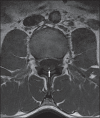

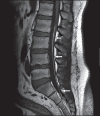
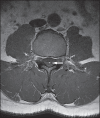

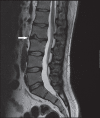
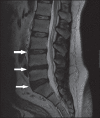
References
-
- Bursara KR, Zomorodi AR, Enterline DS, George TM. The value of magnetic resonance imaging in the evaluation of fatty filum terminale. Neurosurgery. 2004;54:375–9. - PubMed
-
- Rinaldi F, Cioffi FA, Columbano L, Krasagakis G, Bernini FP. Tethered Cord Syndrome. J Neurosurg Sci. 2005;49:131–5. - PubMed
-
- Selcuki M, Coskun K. Management of Tight Filum Terminale Syndrome with special emphasis on normal level conus medullaris. Surg Neurol. 1998;50:318–22. - PubMed
-
- Iizuka T. Fatty Filum Terminale on MRI. The Internet Journal of Spine Surgery. 2006;3:1.
-
- Zimmern PE. Tethered cord syndrome in adult. A rare presentation. J Urol (Paris) 1994;100:93–6. - PubMed
LinkOut - more resources
Full Text Sources
Other Literature Sources
Research Materials
